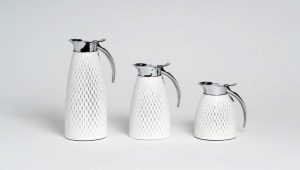How to clean a thermos from tea plaque and remove the smell?

A thermos allows you to keep warm tea and other liquids that are poured into it. Both tea brewing, and coffee, and decoctions of herbs leave plaque and smell inside, often very unpleasant, which cannot be removed by simple washing.
There are different ways to properly clean the heat-saving container, preventing scratches on the flask and keeping the elastic parts in good condition.
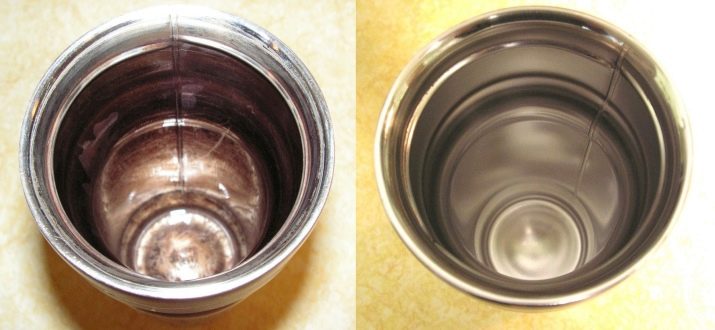
Easy Primary Cleaning Features
If a metal thermos is required, for example, to clean the inside of tea leaves and tea plaque, To get started, you need to do the following.
- Pour out what is left after use, pull out the particles of the broth from under the rubber components of the thermos “inside”.
- Rinse the flask with running water, allowing the jet flowing from the tap to penetrate into the most remote and narrow places, as well as into the joints.
- Fill the bowl with boiling water, adding washing gel. A bar of laundry soap will work too.
- Seal well so that water does not spill, and shake the vessel - the detergent will be able to properly clean the walls of tea.
- After pouring out the soapy water, “walk” with a soft brush or sponge inside the thermos.
- Rinse again, pour out.Wipe the outside of the case.
- Turn over and let the water drain completely onto the towel.
- When it dries, you can not wrap the lid, but simply cover the thermos with a napkin.
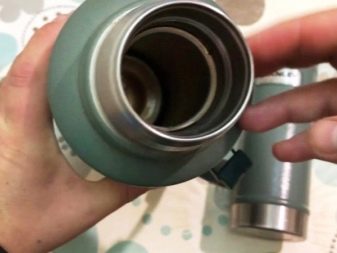
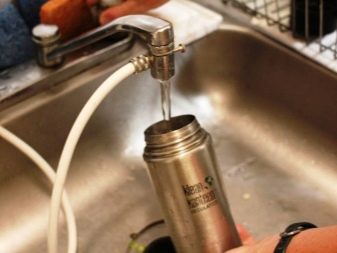
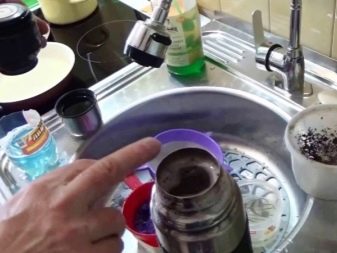
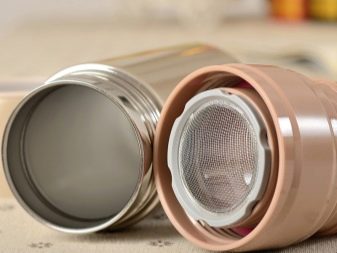
How and with what to remove difficult pollution?
Sometimes the dirty layer on the inner surface of the container is too resistant. It is not always possible to wash a thermos from scale and plaque the first time. In order to qualitatively rinse the vessel from the inside, you can use the various means available in the arsenal of almost every housewife.
If tea stains are visible on the walls, which are not washed in the usual way, you can use the baking powder used when kneading the dough:
- fill a thermos with warm water;
- pour a couple of bags of powder;
- tightly seal the lid (cork) and hold for 2 hours;
- pour out the contents and wash the thermal product.

With a continuous coating on the inner surface, it makes sense to adopt lemon juice (or acid in granules):
- to begin with, you should squeeze half a lemon into a thermos or pour 2 teaspoons of a powdered acidic agent;
- fill the container with boiling water;
- screw it in so that nothing spills, and shake it several times;
- forget about a dirty dish for 4 hours, and if the raid is very dense - at night;
- after pouring out the acidic liquid, rinse with tap water and dry the thermos.
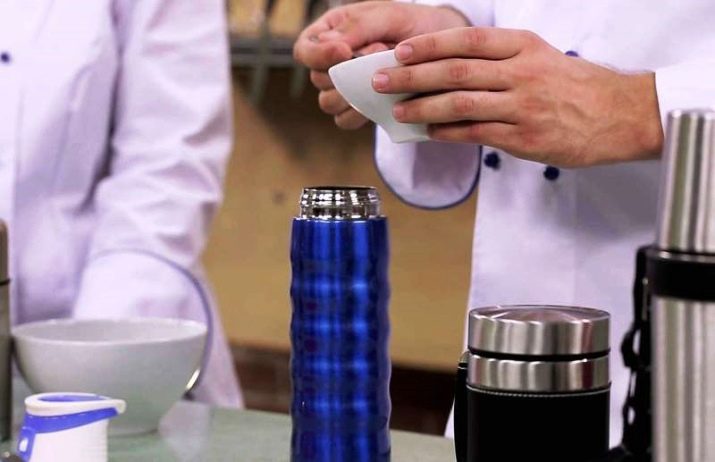
If there is no citrus, then tea or any other stubborn plaque from heat-saving dishes can be removed at home using vinegar - 9%. When there is only vinegar essence, 2 tablespoons (tablespoons) of caustic liquid are added to a glass of water. Recipe:
- fill a thermos with boiling water to a third of its volume;
- pour vinegar under the very neck and shake;
- hold the corrosive liquid in the container for 5 hours, and then rinse the flask with cold water;
- if necessary, clean the remains with a brush;
- at the end, process in the usual way.

A good way to solve the problem is soda, without which no kitchen can do. To enhance the effect, this powder can be mixed with the same vinegar.
If you use just soda, dilute it in water at the rate of a teaspoon per glass of water and fill the thermos with the prepared cleaning compound to the top.

You can also make a paste by mixing baking soda with a small amount of liquid and spreading it over the inside of the thermos. Then fill the vessel with a solution of vinegar (4 parts of water should fall on part of the acidic agent). Leave the container with the cleaning agent for 6 hours. Then empty it. Rinse with dishwashing liquid, rinse vigorously.
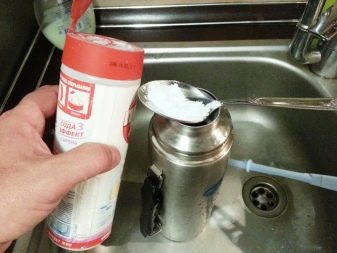
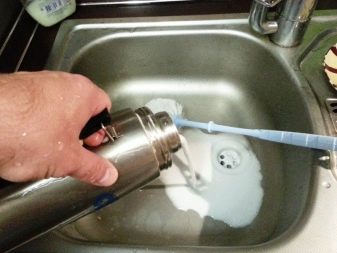
Mustard powder is a substitute for soda. Purification requires the following:
- pour a large handful of the product inside;
- pour hot water;
- screw the lid on and shake the vessel;
- leave the contents in a thermos for a long time;
- after removal, rinse the container well in the usual way.
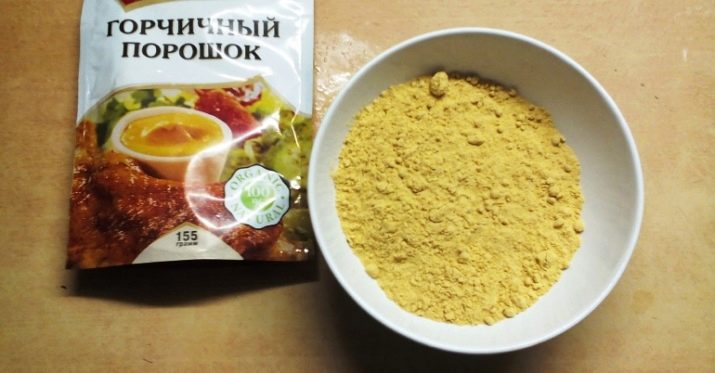
An easy way to remove tea or some other persistent plaque is to use a salt solution:
- put a handful of salt into the flask;
- pour water heated to a high temperature;
- wait 120 minutes;
- wash the thermos
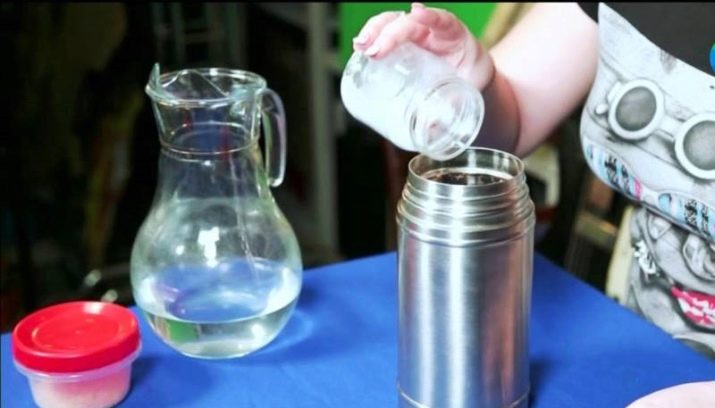
As a cleaning agent, it is convenient to use any cereal, for example barley. Rice grains will work too. Half a glass of the product is placed in a thermos, on top - a couple of tablespoons of soda. The rest of the volume is filled with water. It remains to seal the vessel and shake it so that the impromptu abrasive and soda do their job.

Difficult cases can be handled with a crushed tablet designed to clean dentures.The powder is placed in a flask, and boiling water is poured on top and the lid is screwed on. Then the thermos is shaken several times, after which it remains to rinse well in the usual way.
If the plaque is very strong, you can leave the “tablet” solution in the container for several hours.
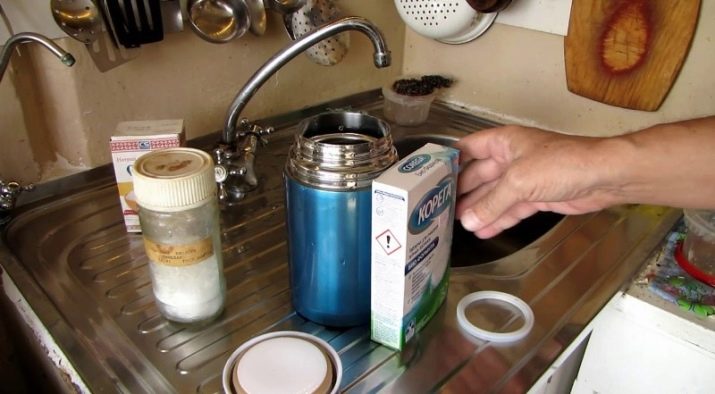
Suitable for cleaning and ammonia. If the remnants of tea or coffee have eaten almost tightly, this tool will help solve the problem. Given that it has a strong smell, it is advised to first pour it into a PET bottle. Make holes in its lid, and thread threads through them. After that, turn the bottle upside down into a flask.
The substance will drain into the dirty thermos along the threads. Evaporating, it will do its job.
Cleansing with ammonia takes up to 7 hours. In especially difficult cases, it is suggested to hold it in a container overnight. After that, wash with soap and dry.
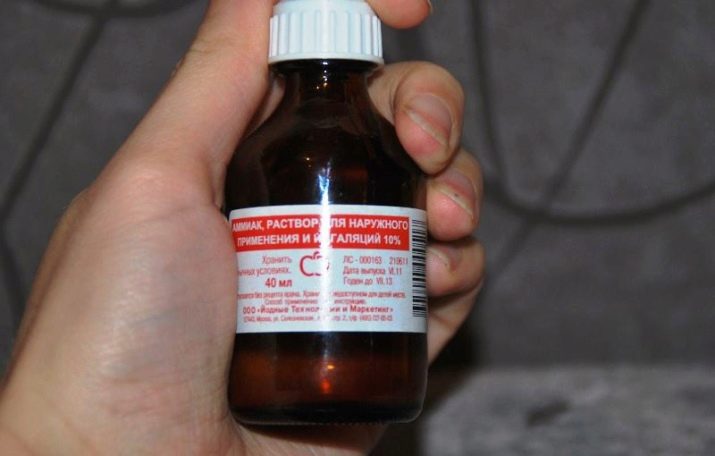
It fights well with plaque and soda. The sweet drink is heated to a high temperature and poured inside for half a day.


In the most advanced cases, use even Whiteness. Take 1 part of a substance containing chlorine for 3 parts of hot water. Mix and pour into a thermos. Close, and pour out after 3 minutes. A thermos freed from contamination will have to be thoroughly washed from traces of bleach.

Remove bad odor
Even if the thermos is washed, often when the lid is unscrewed, a musty smell “bears” from it. Sometimes it smells like mold. This is especially noticeable if the container was not dried well, and then left closed for a long time after a quick cleaning.
Means that are designed to remove plaque from the flask help to eliminate the disgusting odor that has been preserved inside the container.The same mustard powder or salt, placed inside without liquid, successfully absorbs bad "aromas". You can also use:
- activated charcoal, previously ground into powder;
- a bag of tea or aromatic herbs;
- crackers;
- a handful of coffee beans.
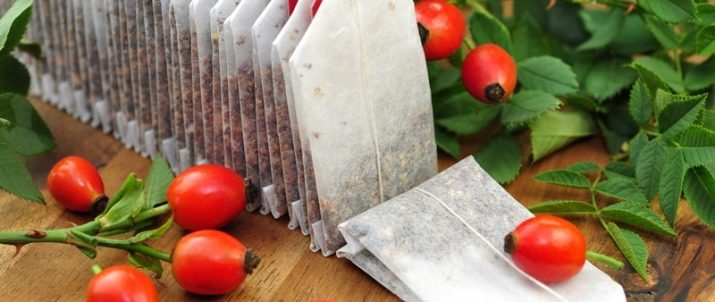
If mold has settled in a thermos, you can pour into it sodium bicarbonate and pour boiling water. Leave the vessel to soak for several hours, then wash and dry well.
Strain juice from one sour citrus, chop the pulp and skin and throw into a thermos. Fill up to the neck with hot water, close with a stopper and soak for several hours.
And to get rid of the smell with lemon juice or soda, just use the same recipes that are used for washing.
What can't be washed?
The persistent desire to get rid of contaminants in the thermos flask sometimes leads to damage to it, therefore it is better to refuse the use of some substances, while others should be used very carefully.
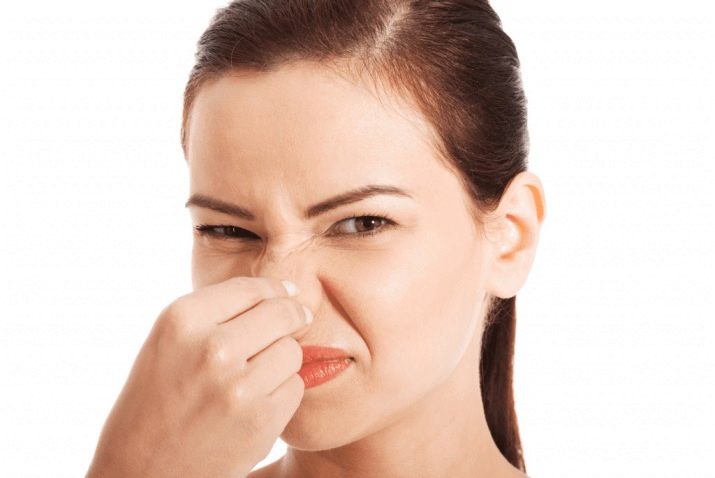
Do not use coarse abrasives such as crushed eggshells or sand, as well as brushes with hard, or even metal bristles. A piece of iron is also contraindicated. Dry substances like salt or soda should not be rubbed into the inner surface. Both must first be diluted with water.
The appearance of even the smallest scratches obtained during inaccurate cleaning leads to the fact that during subsequent use, the plaque sticks to the walls even faster. Bacteria after the operation of the thermos remains more and more, which means that it becomes more difficult to get rid of the smell every time. And the most important thing is that the thermos loses its ability to keep drinks hot, making it a useless item in the kitchen.
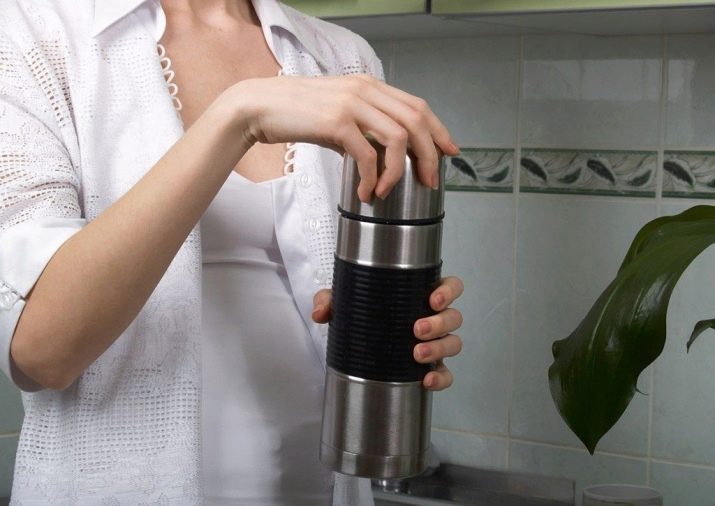
Preventive measures
In order not to have to go to various tricks to return such a vessel to its original appearance and internal neatness, it is important to use it correctly.
- After normal washing, you must always wipe dry all parts of the thermos, and also wait until the “sectors” that are inaccessible for wiping are completely dry. To do this, the product must be kept in a warm place.
- Do not leave the container closed for a long time.
- It is necessary to wash the thermos immediately after use, without postponing it for later.
- At the next wash, it is better not to be limited to simple rinsing, but be sure to use dishwashing detergent.
- The water used to treat the thermos after use should be soft. This prevents scaling.
- If cleaning agents are used that act strongly and quickly, the container must be additionally treated with soapy water and rinsed several times.

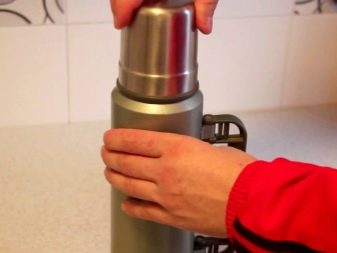
Careful attitude to the thermos will allow you to keep its functionality not for a year, not two, but for decades. A high-quality product will accompany its owner in a variety of life situations, regularly keeping drinks hot - both at home, and on trips, and on trips to nature.
For information on how to clean tea plaque and remove odor, see the following video.






















